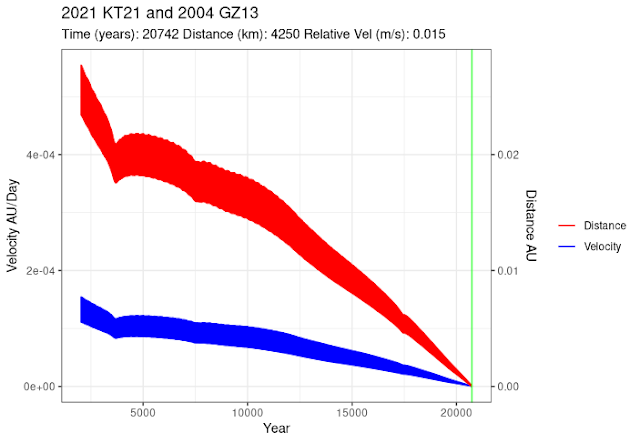Minor Planet Ephemeris Service: Query Results
(612288) 2001 TA253
Based on 5-opp elements from MPO 892206.
Date UT R.A. (J2000) Decl. Delta r El. Ph. V
2025 11 21 000000 07 59 52.7 +37 38 25 2.862 3.494 122.5 13.8 22.9
P/2024 R3 (PANSTARRS)
Based on elements from MPEC 2024-X74.
Date UT R.A. (J2000) Decl. Delta r El. Ph. m1
2025 11 21 000000 08 34 35.7 +36 02 49 2.967 3.508 115.5 14.7 22.8
Orbital parameters integrated at the same epoch
OBJECT a e i peri node long
(612288) 2001 TA253 3.20298 0.268006 14.5865 305.3757 31.9040 337.2797
P/2024 R3 3.20291 0.267791 14.7029 309.5125 33.1242 342.6367
State Vectors (AU, AU/day):
(612288) X:-0.6169 Y: 3.3393 Z: 0.8225 VX:-0.00867 VY: 0.00040 VZ: 0.00128
P/2024 R3 X:-0.9829 Y: 3.2561 Z: 0.8565 VX:-0.00864 VY:-0.00053 VZ: 0.00112Mercury 6 - Backward integration
)O+_06 Integration parameters (WARNING: Do not delete this line!!)
) Lines beginning with `)' are ignored.
)---------------------------------------------------------------------
) Important integration parameters:
)---------------------------------------------------------------------
algorithm (MVS, BS, BS2, RADAU, HYBRID etc) = BS
start time (days)= 2461000.5
) stop time (days) = 102458000.5
stop time (days) = -1e8
output interval (days) = 100
timestep (days) = 0.05
accuracy parameter=1.d-12
Alessandro Odasso















